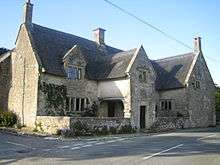Lower Chicksgrove

Lower Chicksgrove is a hamlet on the north bank of the River Nadder in the south of the county of Wiltshire, England. It is about 2 miles (3.2 km) east of Tisbury and 10 miles (16 km) west of Salisbury.
The settlement is recorded in the 12th century as Chicksgrove and a nearby settlement as Stoford; Chicksgrove was first recorded as Lower Chicksgrove and Stoford as Upper Chicksgrove in the later 19th century. Most of the settlement at Lower Chicksgrove in the later 18th century was situated along a north-south lane, west of the crossing of the Tisbury-Fovant and Chilmark-Ebbesbourne Wake roads, where the farmsteads belonging to Tisbury manor stood.
Chicksgrove Manor, which is the largest of these to survive, is said to have been occupied by the Davies family from the 16th to 18th centuries, and was the birthplace of the lawyer, poet, and political writer Sir John Davies (d. 1626).[1] The manor house is Grade II* listed.[2]
For local government purposes Lower Chicksgrove is part of the civil parish of Sutton Mandeville, having been transferred from Tisbury parish in 1986.[1]
Chicksgrove Quarry, a quarry extracting Chilmark stone, still operates at Lower Chicksgrove.
The 2009 film Morris: A Life with Bells On was partly filmed at the Compasses Inn at Lower Chicksgrove.
References
- 1 2 "Victoria County History - Wiltshire - Vol 13 pp195-248 - Parishes: Tisbury". British History Online. University of London. Retrieved 23 May 2015.
- ↑ Historic England. "Chicksgrove Manor (1146012)". National Heritage List for England. Retrieved 23 May 2015.
External links
| Wikimedia Commons has media related to Lower Chicksgrove. |
Coordinates: 51°04′10″N 2°02′38″W / 51.0694°N 2.0438°W